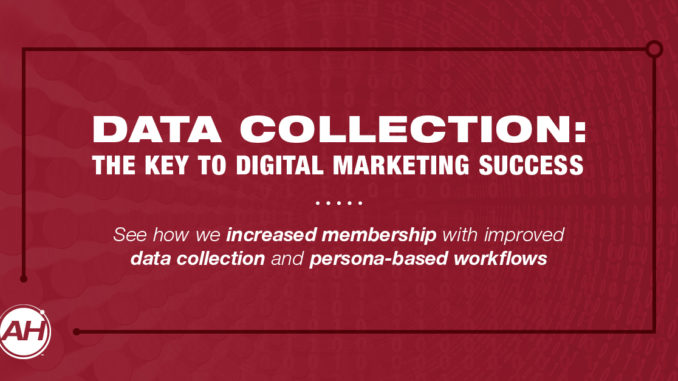
Digital marketing is evolving at a lightning pace, making it difficult for associations and nonprofits to keep up. Adding to this difficulty is the lack of educational opportunities specific to the industry. Often, what’s available focuses too much on theory and not enough on practice. They cram together as many buzzwords and trends as possible, emphasizing theory over practical application.
In a field that changes as quickly as digital marketing does, theoretical knowledge must be supported by practical use of action plans. This was top of mind when preparing to facilitate the ‘How to Build a Successful Digital Marketing Strategy for Your Association’ breakout session at the 2019 VSAE Fall Conference.
Here’s three key takeaways from the session:
1. Data Collection: The Key to Digital Marketing Success
Today’s digital landscape is way too crowded due to decreasing channels and increasing competing solutions, effectively ending the traditional one-size-fits-all approach to marketing. As brands and consumers alike increasingly embrace personalization, marketing that engages consumers on their unique interests and preferences will continue to rise. For associations, this means meeting the demands of its diverse group of members with personalized and tailored experiences. And the accuracy and strength of these experiences directly depends on data collection. If your data offers an incomplete or incorrect picture of your members, your marketing efforts won’t resonate.
2. Topic Clusters: The Most Effective Content Strategy for SEO
Search engines have changed their algorithms to favor topic-based content. As a result, SEO is shifting to a topic cluster model, where a single pillar page acts as the main hub of content for an overarching topic and multiple content pages that are related to that same topic link back to the pillar page and to each other. This linking action signals to search engines that the pillar page is an authority on the topic it covers. This model favors content-focused websites. The good news? Associations are thought leaders in their respective industries, so choosing topics to focus on and building out cluster content plans should be easy-peasy!
3. Pay to Play: The Importance of Social Media Advertising
The 2018 Facebook algorithm change was designed to center content around individuals’ friends and family members, rather than prioritizing posts from Business Pages. As a result, organizations have seen significant drops in organic reach and engagement. Simply put, to get any kind of traction today, you have to pay-to-play. The good news? Social media advertising is an effective way to nurture leads and transform prospective members into loyal ones. With social media advertising, you can target the ideal audience for your association. Not only does social media advertising present better opportunities to nurture leads, it’s also cheaper. According to LinkedIn, you will spend about $57 on direct mail advertising to reach 1,000 people. On social media, you will spend under $3 to reach the same audience.
